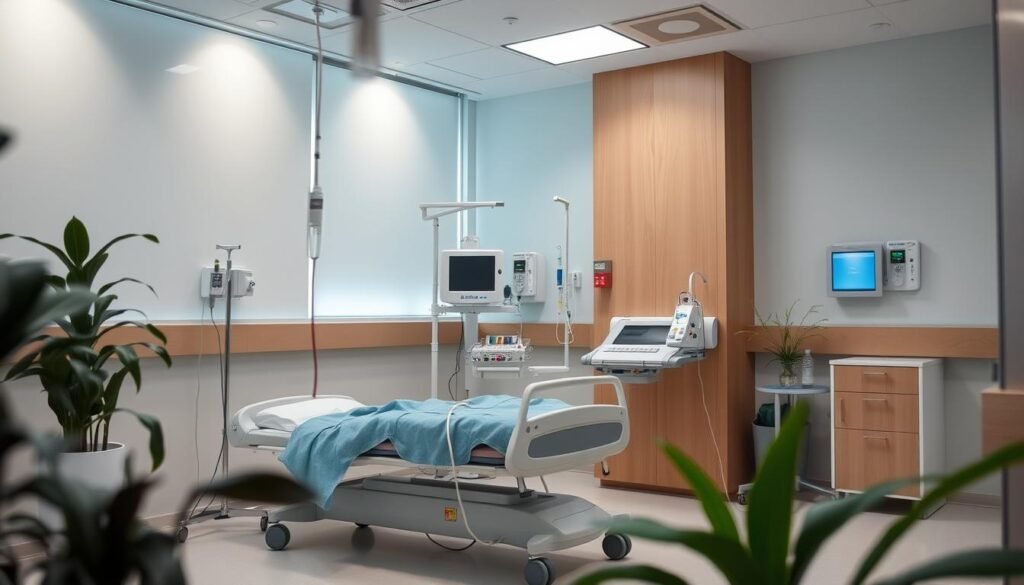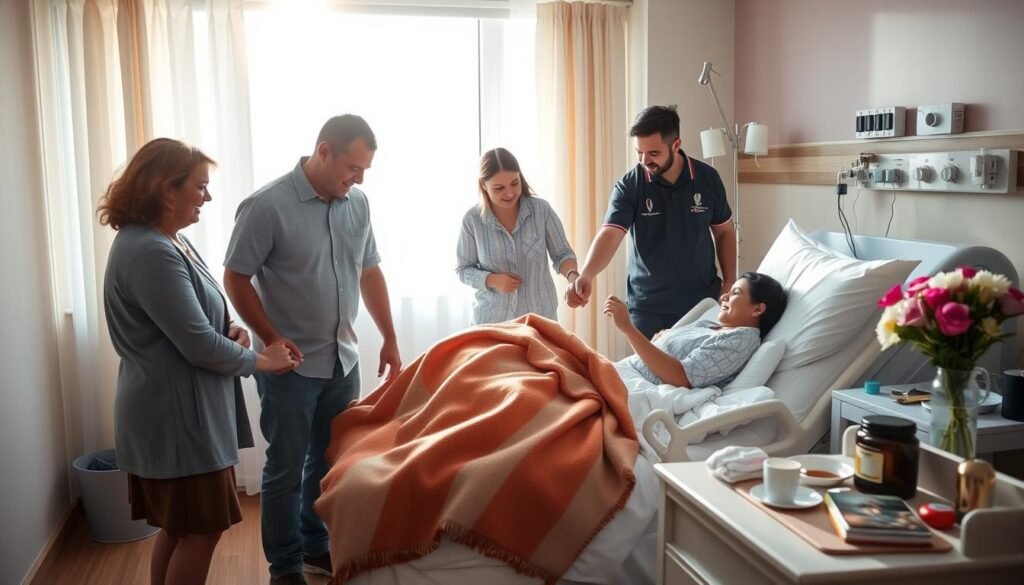Did you know nearly half of the people with lung cancer have adenocarcinoma at stage IV? That shows how quickly this cancer type can spread. Learning to deal with stage 4 adenocarcinoma lung cancer is key for better outcomes.
This guide helps patients, caregivers, and medical teams find the right treatments. It talks about everything from chemo to new therapies based on your genes. The guide also explains how changing your lifestyle and getting palliative care can help improve life quality.
For more information, check out this resource for an in-depth look at treatment options for stage 4 adenocarcinoma lung cancer.
Key Takeaways
- Stage 4 adenocarcinoma lung cancer indicates advanced cancer spread.
- Timely intervention and understanding treatment options can enhance outcomes.
- Targeted therapies focus on individual genetic mutations for more effective treatment.
- Palliative care plays a vital role in managing symptoms and improving quality of life.
- Participation in clinical trials can provide access to experimental treatments.
Understanding Stage 4 Adenocarcinoma Lung Cancer
Stage 4 lung cancer, or adenocarcinoma, is the most advanced stage. By this time, cancer has often spread beyond the lungs. This complicates treatment. It’s important to know how adenocarcinoma acts and what symptoms it causes.
About 40% of non-small cell lung cancers are adenocarcinoma. This type tends to show up in nonsmokers, women, and younger people. Signs like ongoing cough, chest pain, breathing trouble, weight loss, and being very tired are typical. These signs often mean the cancer is found late, which affects survival chances.
Only 8% of patients with advanced non-small cell lung cancer survive past five years. Catching cancer early could lead to early treatment. Tests like X-rays and CT scans are key in spotting cancer’s growth.
Looking at cancer cells under a microscope helps decide how to treat adenocarcinoma lung cancer. Treatment plans are made based on cancer’s traits, its spread, and the patient’s health. Knowing about one’s diagnosis helps in making treatment choices.
The Importance of Early Diagnosis
Getting diagnosed early is crucial for lung cancer patients. It helps improve their chances of getting better and living longer. Low-dose CT (LDCT) scans are a major way to catch the disease early. The American Cancer Society suggests LDCT scans each year for people 50 to 80 who smoked a lot, especially those who have smoked for 20 pack-years.
Finding out if someone has lung cancer spreading can be hard. Many signs are similar to those of chronic lung problems, causing wrong diagnoses. It’s key for people at risk, like smokers and those with lung cancer in the family, to get regular health checks. Knowing the differences helps doctors find lung cancer early. This early action can make treatments work better (source).
New tools in screenings, like better imaging and bronchoscopy, help find lung cancer sooner. Tests for cancer cells in blood also offer early detection chances. Catching cancer early means less chance of it being late-stage. This is great for managing the disease and making treatment plans that fit the patient well (source).
| Screening Method | Target Population | Benefits | Considerations |
|---|---|---|---|
| Low-Dose CT (LDCT) | Aged 50-80 with 20 pack-year smoking history | Find cancer earlier, reducing mortality | Low radiation exposure, may require follow-up tests |
| Bronchoscopy | High-risk individuals | Direct visualization of lung tissues | Invasive, potential complications |
| Liquid Biopsy | All patients | Non-invasive, early detection | Still under research, variable accuracy |
Using different methods to screen for lung cancer makes early diagnosis more likely. Being aware and knowledgeable about these methods improves health choices. And that can save lives.
Managing Stage 4 Adenocarcinoma Lung Cancer
Handling Stage 4 adenocarcinoma lung cancer means knowing your treatment choices. These treatments are tailored to meet each patient’s needs. At this stage, cancer might have reached both lungs and far-off organs. But, there are still several ways to help improve life and extend it.
Overview of Treatment Options
Key treatments include chemotherapy, targeted therapies, and immunotherapy. Chemotherapy is essential for tackling cancer cells all over the body. Targeted therapy zooms in on specific genes, like the EGFR gene, for a more personalized touch. Immunotherapy is a breakthrough, getting the immune system to fight cancer better.
Personalized Treatment Plans
It’s crucial to have a treatment plan made just for you when managing Stage 4 adenocarcinoma lung cancer. These plans consider your unique genetics, health, and biomarker profiles. For example, studies show that women and non-smokers with EGFR mutations really benefit from targeted therapies, boosting survival chances. As medical knowledge grows, these customized plans guarantee the right treatments are used, making them as effective as possible.
| Treatment Type | Characteristics | Expected Outcomes |
|---|---|---|
| Chemotherapy | Systemic, often used as a first-line treatment | Can help shrink tumors and alleviate symptoms |
| Targeted Therapy | Focuses on specific mutations like EGFR | May result in higher response rates for certain patients |
| Immunotherapy | Stimulates immune response against cancer cells | Potential for durable responses in some patients |
Conventional Treatment Paradigms
Patients with stage 4 adenocarcinoma rely on standard treatments. These include chemotherapy and targeted therapy, chosen based on their health and genes.
Chemotherapy Approaches
Chemotherapy is key in treating advanced adenocarcinoma. It uses drugs like cisplatin and pemetrexed. These help manage symptoms and can extend life. The goal is to shrink tumors, slow down the disease, and ease issues like coughing or breathlessness. This makes chemotherapy a critical option for doctors treating lung cancer.
Targeted Therapy Options
Targeted therapy is a major step forward in lung cancer care, especially for adenocarcinoma with certain genetic mutations. Treatments focus on cancer cells with EGFR, ALK, and MET changes. About 40% of non-small cell lung cancer patients have an EGFR mutation. This number is higher in women. Drugs like gefitinib and osimertinib specifically target these mutations and often work better than traditional chemotherapy.
This method customizes treatment to each patient’s genetic makeup, aiming to boost survival and life quality. It highlights how lung cancer treatment is constantly evolving.
| Mutation Type | Prevalence in Adenocarcinoma | Targeted Therapy Options |
|---|---|---|
| EGFR | 40% (females 44%, males 24%) | Gefitinib, Osimertinib |
| ALK | 5% | Alectinib, Crizotinib |
| MET | 12% (Western), 1-4% (Asian) | Capmatinib, Tepotinib |
| RET | 1.7% | Selpercatinib, Pralsetinib |
| HER2 | 2-4% | Trastuzumab, Neratinib |

Advancements in Immunotherapy
Recent progress in immunotherapy has greatly changed how we treat lung cancer, especially Stage 4 adenocarcinoma. It has become a key player, joining surgery, chemotherapy, radiation, and targeted treatments. Drugs like pembrolizumab and nivolumab are making a big difference in non-small cell lung cancer (NSCLC), especially when PD-L1 levels are high.
This treatment works by helping the immune system find and kill cancer cells better than before. If a patient’s cancer shows PD-L1 in 50% or more of cells, they could live longer than with just chemotherapy. Still, even with its success, only about 29% of lung cancer patients are currently getting immunotherapy. This shows we have a lot more we can do with this approach.
Between 20% and 30% of patients respond well to immunotherapy. However, how well it works can vary a lot from person to person. Some patients may experience side effects from the treatment. These can range from mild to very serious and affect about 70% of patients. To manage these, doctors often use corticosteroids, but it’s sometimes hard to diagnose these issues outside of research studies.
Researchers are constantly looking for better ways to combine immunotherapy with other treatments. This could help improve how well the treatment works and make positive results last longer. For example, the Trial of Measles Virotherapy in Combination With Atezolizumab is one study trying to do just that for NSCLC patients. For more information on the newest treatments for lung cancer, please check this source.
Palliative Care Considerations
Palliative care is key in helping patients with Stage 4 adenocarcinoma lung cancer live better. It not only eases physical pain but also supports emotional and mental health. Patients and their families get help to cope.
Symptom Management Strategies
Managing symptoms well lets cancer patients stay comfortable. Palliative care helps cut down on pain, nausea, and tiredness. It uses different treatments to ease these issues.
- Pain management through medications and interventions
- Respiratory support and therapies to relieve breathing difficulties
- Nutritional support to combat fatigue and enhance overall well-being
- Psychological support to address anxiety and emotional turmoil
By using a broad range of symptom management strategies, doctors can improve patients’ lives with lung cancer.
Emotional and Psychological Support
Cancer patients get emotional help through one-on-one counseling and support groups. Dealing with lung cancer can make patients feel very stressed. Palliative care teams include professionals trained to help with these feelings.
Family members get support too, making it easier to care for a loved one. This support can make a big difference in everyone’s life.
| Symptom | Palliative Care Treatment | Potential Benefits |
|---|---|---|
| Pain | Pain medications, nerve blocks | Improved comfort, better quality of life |
| Nausea | Anti-nausea medications | Increased appetite, less discomfort |
| Anxiety | Counseling, relaxation techniques | Emotional well-being, reduced stress |
| Fatigue | Nutritional support, physical therapy | Enhanced energy levels, improved daily function |
Palliative care is easy to find, available in hospitals, clinics, and even at home. Most insurance plans cover these services, helping families during tough times.
Clinical Trials and Experimental Treatments
Exploring new ways to manage stage 4 adenocarcinoma lung cancer is crucial. Clinical trials give patients access to experimental treatments for lung cancer not yet widely available. It’s important for anyone considering these trials to understand the potential benefits and risks.
A recent clinical trial showed impressive results for a patient. After the trial, doctors couldn’t find any cancer in his body. This trial looked at how immunotherapy and stereotactic body radiotherapy can be timed effectively.
The patient underwent five radiation sessions followed by biweekly infusions of nivolumab and ipilimumab. These drugs are part of new immunotherapy treatments targeting cancer cells. Those in the trial saw few side effects, making it a promising option. The patient continued with nivolumab even after the trial, highlighting the importance of ongoing research.
Patients looking into trial opportunities should talk openly with their oncologists about available studies. Advancements from clinical trials are vital for better treatment methods and patient outcomes.
| Treatment Type | Recommended For | Details |
|---|---|---|
| Combination Cytotoxic Chemotherapy | PS 0 to 1, appropriate PS 2 cases | Recommended for patients without EGFR or ALK mutations. |
| Platinum-Doublet Therapy | PS 0 to 1 | Includes bevacizumab with carboplatin and paclitaxel. |
| Targeted Therapy | Patients with EGFR mutations | Includes afatinib, erlotinib, gefitinib; crizotinib for ALK rearrangement. |
| Second-Line Treatments | Patients with Nonsquamous/Squamous Cell Carcinoma | Docetaxel, erlotinib, gefitinib, or pemetrexed recommended. |
| Third-Line Options | Patients not previously treated with certain medications | Recommended for those who haven’t received erlotinib or gefitinib. |
Clinical trials not only offer new treatment options but also help understand the effectiveness of therapy combinations. They provide hope and focus on potential breakthroughs in lung cancer treatment.
Critical Role of a Support System
Support systems are crucial for those battling Stage 4 adenocarcinoma lung cancer. They include family, friends, and healthcare teams. Each offers unique help like emotional, practical, and social assistance. A strong support network greatly improves the cancer care experience.
Family members offer comfort and understanding. They help lessen loneliness that comes with the disease. Healthcare professionals provide customized care plans. They make sure the patient’s needs are met.

There are many resources for patients and caregivers. Counseling services let people share their fears and frustrations. Support groups offer a place for shared experiences and tips for coping. Studies show that social support improves mental health. It’s very important for those navigating cancer care.
- Encouragement of open communication: Talking about feelings can help emotional health.
- Access to educational resources: Knowing about the disease and treatments helps in making decisions.
- Emphasis on self-care for caregivers: Caregivers need to look after their own well-being to support others effectively.
Understanding the importance of support systems helps improve the treatment journey. A strong network can make a big difference in health outcomes, resilience, and life quality.
Managing Side Effects of Treatment
Dealing with side effects is key for Stage 4 adenocarcinoma lung cancer patients. Effects like nausea, vomiting, fatigue, and hair loss impact daily life greatly. Effective management improves comfort and helps patients stick to treatments.
Fatigue is very challenging and might require changing how one does daily tasks. Helpful steps include getting help, prioritizing tasks, taking breaks, and getting blood checks. Light activities such as walking or yoga can also boost energy and health.
Nausea and losing appetite are common with advanced treatments. Eating small meals often, choosing bland foods, and trying liquid diets can help. Meals should be enjoyable, creating a happy environment for eating.
Breathing problems can be due to fluid buildup or blockages. Using deep breathing techniques and sitting forward can ease discomfort. Sometimes, a fan helps by moving air around, making breathing easier.
Emotional support is very important. Joining support groups, talking with mental health experts, and attending relaxation sessions help emotionally. This kind of care lets those with Stage 4 adenocarcinoma lung cancer live better during treatment.
End-of-Life Care and Considerations
End-of-life care is critical for those with Stage 4 adenocarcinoma lung cancer. It focuses on advanced care planning and hospice care options. Patients, families, and healthcare teams should talk openly about the choices at this tough time.
Palliative care is key to managing symptoms and improving comfort. It goes beyond hospice care, helping with physical, emotional, and overall well-being. This care boosts the quality of life by meeting individual needs and wishes.

- Comprehensive symptom management strategies
- Emotional and psychological support for patients and families
- Incorporation of multidisciplinary teams consisting of doctors, nurses, social workers, and other specialists
- Accessibility of palliative care across various settings such as hospitals, clinics, and homes
The palliative care team provides full support, not just at life’s end. They offer symptom relief, pain medications, and counseling. This helps patients handle advanced lung cancer with dignity and comfort.
| Type of Supportive Care | Purpose |
|---|---|
| Airway Procedures | Open airways for easier breathing |
| Pain Management Medications | Reduce pain levels and improve comfort |
| Emotional Support | Address psychological concerns |
| Nutritional Supplements | Enhance physical strength and wellness |
| Integrative Services | Provide complementary therapies such as massage and mindfulness |
End-of-life care for advanced lung cancer focuses on a dignified, supportive setting for patients and families. By exploring hospice care, families can make the experience more compassionate and calm during hard times.
Nutrition and Lifestyle Modifications
Nutrition is key for cancer patients, especially those with lung cancer. It boosts health and improves life quality. Eating well helps the body handle treatment and lessens side effects. Meals should be rich in protein, fluids, and essential nutrients.
A dietitian who knows about lung cancer can help. They make meal plans that meet patient’s needs. Adding lifestyle changes can also promote a healthier daily life.
A simple diet might reduce discomfort. Soft, low-fiber, and mild foods are best. For example:
- Low-fat dairy products
- Cooked or canned fruits and vegetables
- Refined white flour products
- Lean proteins cooked without added fat
- Tea steeped for a shorter time
Having a support system is crucial for nutrition. Patients and caregivers can get help with meals from others. Palliative care teams also aid in handling side effects and nutrition.
Making healthy choices is part of being active in health care. Stopping smoking improves lung health and reduces disease risk. Exercise cuts down fatigue, boosts mood, and keeps weight in check. These are vital for fighting cancer.
Studies show that good nutrition and exercise help with treatment. More energy and protein intake can lead to better outcomes. Omega-3s may lower inflammation and ease chemo effects. Proper nutrition lets patients fight infections better and manage treatment.
Joining support groups, like Lung Cancer Survivors Online, offers emotional and nutritional advice. For more help, calling the Lung HelpLine at 1-800-LUNGUSA can guide on diet needs.
Conclusion
Handling Stage 4 adenocarcinoma lung cancer needs a detailed plan that is personalized. Each patient’s experience is different, and treatments should be customized for the best results. Using treatments like chemotherapy, targeted therapy, and immunotherapy is crucial. They help reduce symptoms, better quality of life, and might extend life.
The future of treatment is always improving because of new research and advances. It’s vital for patients to keep up with these changes. Being active in their own care is very important.
Taking care of both the physical and the emotional sides of cancer is very important. Palliative and supportive care play a big role. They help improve a patient’s overall health. This approach proves that full care is key.
Patients should also consider clinical trials for new treatments. These trials can offer new options that aren’t available to everyone. Staying informed about things like the latest treatment options for Non-Small Cell Lung helps. It gives patients control and hope.
Thanks to ongoing studies and teamwork among doctors, there’s hope for better treatments. This can make a big difference for those facing this tough disease.